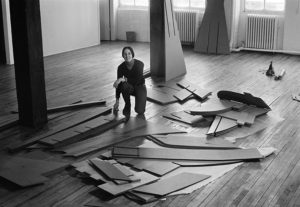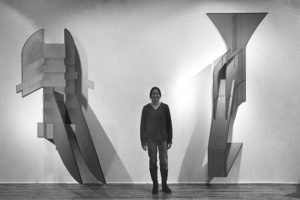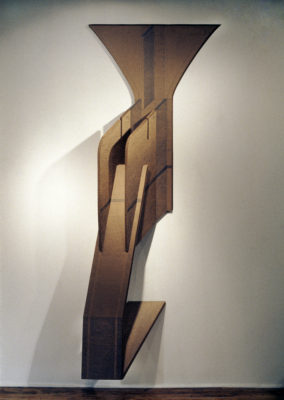Diane Simpson: Cardboard–Plus, 1977–1980
By: Jacquelyn Gleisner
Four parallel planes of cardboard extend from the wall at a 45-degree angle in Diane Simpson’s large wall-mounted sculpture, Corrugated Drawing #2 (1978). Simpson, whose works were included in the 2019 Whitney Biennial as well as several recent solo museum exhibitions, completed this sculpture soon after receiving her graduate degree from the School of the Art Institute of Chicago. This piece represents her transition from a two-dimensional practice rooted in drawing and printmaking into sculpture and installation-based art. This work also exemplifies Simpson’s early investigation of practical materials such as cardboard, the subject of her current solo exhibition, Diane Simpson: Cardboard–Plus, 1977–1980 in the Zilkha Gallery at Wesleyan University (Through March 1).

Simpson’s process began by rendering specific references from Japanese architecture, instruments, and furniture into delicate graphite drawings on graph paper. She then translated these sketches into a series of sculptures using interlocking planes enforced by a system of hidden wooden dowels. Because Simpson never used any sort of glue to adhere the various pieces together, her large-scale sculptures can be unassembled. Both the pragmatism of Simpson’s approach and her choice of material originated from necessity. The recent graduate was working in her dining room rather than an artist’s studio at this time. Likewise, cardboard was affordable and easy to manipulate and later, pack flatly for storage.

The skewed perspective of Simpson’s drawings is a defining feature of her late 1970s sculptures. Walking around a free-standing piece such as Dialog (1978), a viewer’s understanding of the form unfolds radically. From one vantage point, the sculpture appears constricted, while from its side, the sculpture occupies a larger footprint than anticipated. Simpson’s series—with its formal rigor and compressed sense of space—recalls the idea of perspective as an illusionistic tool—however volumetric, Simpson’s pieces often feel more akin to complex wall drawings than sculptures.
This body of work, shown together for the first time in 40 years, inhabits the limestone and concrete interior of the Zilkha Gallery with surprising comfort. The subtle crayon rubbings on the surfaces of Simpson’s cardboard mimic the natural textures of the space’s grand stone walls. The earthy palette of warm brown, heather gray, and soft pink alongside Simpson’s oblique angles resonate in this austere environment. Against this ideal backdrop, the exhibition offers a rare glimpse into the genesis of the octogenarian’s expansive career.

